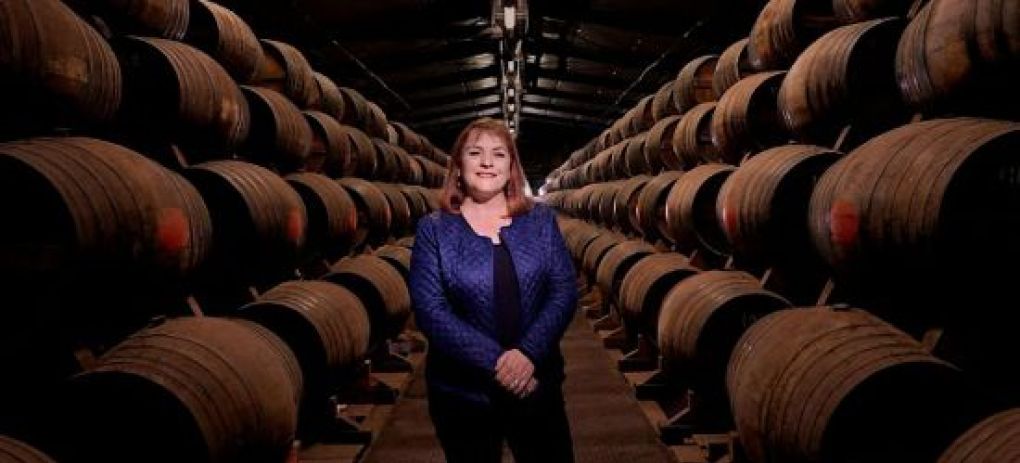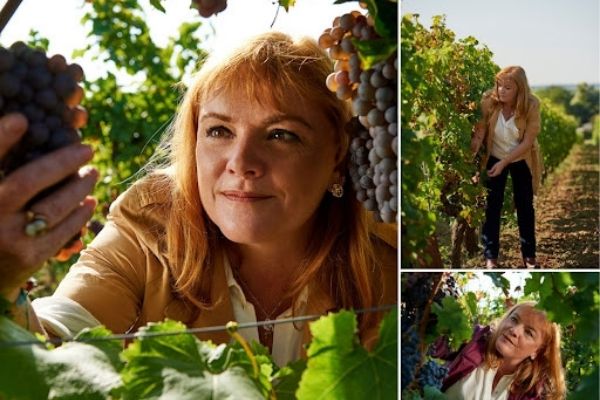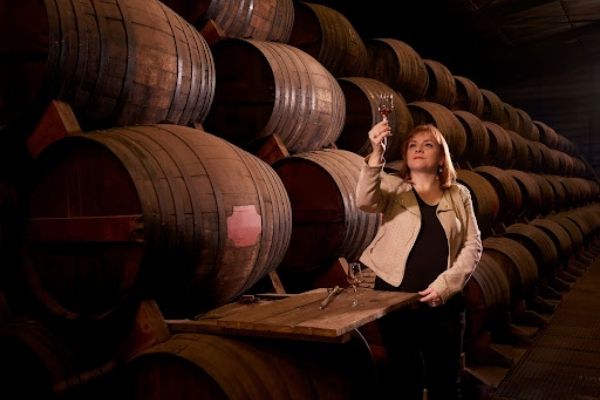
16/01/2024 St-Rémy's Master Blender, Cécile Roudaut, discusses the sustainable development approach taken by St-Rémy, the rich history of Brandy, why consumer education is important, and much more.
Cécile Roudaut is the Master Blender for St-Rémy, which is one of the world’s most prestigious brandies hailing from France. Born in the Loire Valley, Cécile has always been around wines and vineyards. She started her career in wines from a wine estate in Saumur where she took care of quality control. Progressing with her role, she joined Rémy Cointreau in 1997, after two decades of hard work and mastering the art of blending she was appointed Master Blender. She has helped to create some of the unique and limited edition blends for St-Rémy and maintain the authenticity of this iconic and historic brandy. Currently, she is responsible for monitoring the quality, research, and development, helping with brand strategies, proposing creative ideas, and creating new blends. In this interview, she shares her knowledge and tips on creating some of the best spirits from her lifelong experience working in the historic distillery.
[[relatedPurchasesItems-31]]
Tell us a little about yourself? Having a background in Biological Engineering, what inspired you to join the Beverage Distillation industry?
Originally I wanted to be an archaeologist and I studied biology and did my internship in cosmetics. As my career progressed, I joined a wine estate in Saumur, where I was responsible for quality control. I took oenology courses and discovered all about winemaking and blending techniques from the winemaker. It was a revelation! As well, for many years I have been teaching sensory analysis at the University of Angers, in the Loire Valley. I like the exchanges with the students, I find them enriching for them as for me. There are lectures to learn theory, essential and then practical work around all kinds of foods.
I joined Rémy Cointreau Group in 1997 to work within the Research & Development. I have been responsible for several brands in the Liqueurs & Spirits Division, notably St Rémy. And in 2016 I was appointed Master Blender.
What does your typical day look like?
I arrive early in the morning at the distillery. I have my program well established, but often I have to deal with unplanned other topics. I have to monitor the process, select the raw materials, so a big part of it is in the sensory analysis laboratory.
My favorite moments are the conclusions after long tasting sessions. I meet my small team and we proceed to consolidate our tasting comments, we then look for a consensus. Then I make the decisions on the next steps, what do we do? What is positive, what is acceptable, what is wrong, what needs to be improved. It is a real moment of exchange but a strong and unavoidable moment for the decision-making which will then reveal the quality of Brandy St-Rémy.
According to you, what makes a spirit great? Where do you draw inspiration from while selecting Eaux-de-vies and blending new spirits?
For a great spirit, complexity is important but finesse and subtlety are essential.
We need a nice balance to provide harmony and not lead to aromatic incompatibility. The perfect composition is the effect obtained after blending several Eaux-de-vie together.
It comes about because the smell and the taste stem from the different raw materials which have been used. A new entity is born. The perfect match requires the right doses of each raw material.
There is a mastery involved in the formulation so the result is no real surprise. But the aging process can sometimes provide a number of surprises, occasionally unexpected. It's a long-term journey, sometimes frustrating but ultimately rewarding. A development process is never linear, it turns right and left.
The inspiration comes from many sources: cosmetics, cakes, ice creams, chocolates, confectionery, etc. There is an abundance of ideas – you just need to find them.
The priority is to retain the fruity and harmonious character of St-Rémy. Its olfactory notes are a bit like musical notes, they must be harmonious and not discordant or cacophonous. We do not really know what we want to achieve and yet we already have it in mind. We know where we are going before we get there thanks to the range of tastes and smells we experience.
It is not a sum of “Eaux-de-vie” but a blend, a coherent mix that produces the best balance. It’s detailed work, with delicate changes which combine to produce a perfect blend.

What role do you think Distributors and retailers play in the development of a new spirit? How do you think they can help you to increase sales and how can you work with them to innovate and expand?
When we think of brandy today we might imagine a connoisseur who enjoys all the incredible flavors that this spirit provides.
But let's not forget that this product, due to its incredible versatility can be a wonderful ingredient in many cocktails. Brandy has a long, rich history of being enjoyed in classic cocktails. These traditional drinks have been the driving force behind the current mixology culture, and that has both restored Brandy's place in the cocktail world and garnered it a younger fan base.
I think that consumer education is essential. In fact, because the brandy market is vast and growing, we find many completely disparate products.
Some products have very nice aromatic qualities and have benefited from a rigorous process with a fine selection of raw materials, a careful distillation, and an optimum aging process. But other products are the complete opposite.
Also, the consumer needs an explanation to be able to distinguish between them. They need these explanations in order to understand how beautiful brandy can be as a product. This is when distributors and retailers have a key role to play.
There is a need for education on how to consume Brandy, where, and when.
It is for this reason that I would like to work closely with them to send them messages but also to listen to their needs.
What is something great about St-Remy that you think no one knows about?
I think that St-Rémy Brandy is transparent. The information is accessible but perhaps poorly known, which is essential and should be remembered.
What makes St-Rémy really unique is that every stage is made in France. We use only French wines that are distilled, matured, blended, and bottled in France.
For me, what makes St-Rémy unique is our sourcing. We don’t source our Eaux-de-Vie in one unique region. St-Rémy is really rich from the diversity of French vineyards: Champagne, Loire-Valley, Bordeaux, Burgundy, Languedoc-Roussillon, and of course… the Loire Valley, particularly high in my heart. You should keep in mind that each French vineyard is unique in terms of soil, climate, and grape varietals that are cultivated. That’s why each region provides a different Eaux-de-vie. For instance, the Champagne region will provide Eaux-de-vie with structure and vegetal notes, while Languedoc-Roussillon will provide Eaux-de-vie with liveliness and yellow fruits aromas. For me, this unique diverse sourcing is at the origin of our fruity and harmonious style.
In our process, a very specific point is the historical use of small casks, no more than 350 liters, which makes a big difference. The interaction surface between wood and eau-de-vie is higher than in larger vats and provides faster and stronger development of rich and harmonious aromas.
What are some of the recent upgrades and innovations in terms of technology in the distillery? What do you think are some of the upcoming innovative Spirits trends in the market?
Through the inventory of fixtures for sustainable development approaches, we have constantly improved the processes. We want to manage as fairly as possible and reduce our carbon footprint.
Overall the quality of brandy has never been so good. Since the world is now rushing to plant more sustainably-farmed orchards and vineyards, the way forward for Brandy is being reshaped by environmentally-friendly agriculture which can only improve what is regarded as a wonderful, life-enhancing alcohol product. Advances in wood maturation, fermentation, and distillation are likewise contributing to a brighter future for all the world's brandies.

How do you focus on sustainability while making your spirits?
As you know St-Rémy Brandy is part of the Rémy Cointreau group and Rémy Cointreau has a centuries-long history of working to preserve and pass on the terroirs that are the cradle of its exceptional wines and spirits. From vines to orange trees and from cereals to sugar cane, the Group committed very early on to securing certification for its terroirs in pursuit of responsible and sustainable farming. In fact, the Group is targeting to have 100% of its ingredients coming from terroirs that are certified for their sustainable and responsible agriculture practices by 2025 (64% in 20/21). St-Rémy is actively contributing to this Group’s target, by increasingly sourcing its wines from certified vineyards (Organic, Terra Vitis, HVE, ..).
Beyond sustainable farming practices, the Group also wants to promote its terroirs as “a solution” in the fight against climate warming. To that end, it wants to ensure that its living soils play their full part in combating global warming by maximizing their potential for carbon sequestration. In order to measure the potential and track the achievement of our terroirs as carbon sinks, Rémy Cointreau recently announced a partnership with Genesis (formerly Greenback SAS), which uses a combination of soil samples and metadata to measure the impact of farming practices on soil based on three key indicators: pollution, biodiversity and carbon sequestration.
This project will help drive forward Rémy Cointreau’s Research and Development strategy in the areas of wine growing and cereal crops, enabling the Group to help winegrowers and farmers adopt increasingly climate- and biodiversity-friendly practices.
Lastly, the Group contributes to climate actions in its two key markets: the US and China. Beyond helping to avoid or sequestrate carbon, these actions also support initiatives to protect the territories (such as water conservation) and communities most vulnerable to climate change (by promoting diversity and savoir-faire transmission for instance) in keeping with the Group’s values. In southern China, the Group will notably contribute to reforesting the Karst region, which is part of the UNESCO’s World Heritage list and which is undergoing desertification, with the planting of 33,000 hectares of native species. Besides, within the local community, some 30,000 people will be trained in the planting and maintenance of these trees. In the United States, the Group participates in improved forest management projects in Washington state and in the southern Appalachians.
Overall, Group’s efforts to promote sustainable agriculture and protect biodiversity is regularly recognized: for the 2nd year in a row, Rémy Cointreau is on the podium of the most responsible French companies in the Food & Beverage sector, according to a study published by French magazine Le Point in partnership with Statista, an independent institute. Ranked number 2 on the overall list, the Group is by far number 1 on the Environment criterion.
This amazing result confirms our commitment and is a great reward for our teams, who are resolutely committed to “The Sustainable Exception”, dear to Rémy Cointreau.
What is the biggest challenge you face in your role? What is the one tip you would like to give someone who is looking forward to joining the beverage distillation industry?
The ongoing challenge is to renew our range, create the best combination, find inspiration, continually imagine new ideas, and never be discouraged. Even if a project does not succeed and we have spent months or years on it, it’s important to remain positive and keep creating.
We must not necessarily think of perennial products but of limited editions which inspire the curiosity of the consumer, it’s their thirst for novelty, always looking for new and high-end products which is the key.
To join the beverage industry you need to be curious, have an open mind, taste without a priori different products to constantly improve and enrich the potential aromatic palette. You should be rigorous, stubborn too because even if things do not work right away it always comes good in the end. Doing a job like mine is exciting and you have to savor the successes and learn from the failures, remain humble as you never know everything, and must listen to the people around you. There is always so much one can learn from others.

How do you think a distiller or blender can help in driving marketing and sales personally?
A master blender must be inspiring to drive marketing or to drive sales. There are 2 forms of inspiration:
First, a rational one: I take the raw materials and want to mix them together. Secondly, a marketing inspiration incorporating a story or a trend in the marketplace.
Then there is also personal inspiration, open-mindedness, testing, it takes time to get the perfect product – it’s not simply luck.
Luck plays a role, as does inspiration coming from those around me, benchmarking, competitors’ products, cooking, gastronomy, etc.
Marketing can be a good source of inspiration to encourage us and the Master blender can help in return.
I need to be bold, not restrained by classic formulations, but mix the products correctly, meticulously noting my methods to be sure that I include all the correct notes and spices so that others may appreciate the final product.
Finally, which are some of your favorite spirits you have on your shelf other than St. Remy?
My first favorite exceptional spirit is Cointreau liqueur. With this, lemon juice, and St Rémy XO, you can make a wonderful sidecar. I also really like Mount Gay rum from Barbados, especially the XO which is powerful and complex. Finally, The Botanist gin is a marvel of complexity and aromatic elegance.



